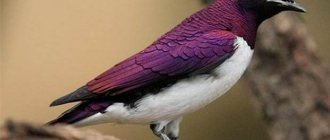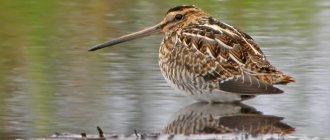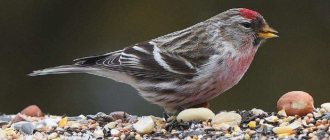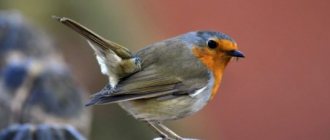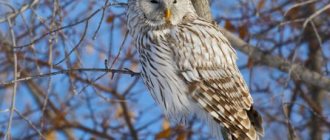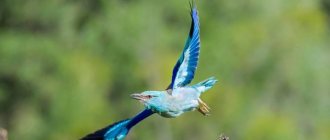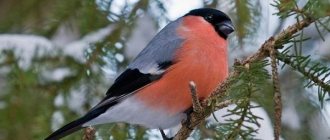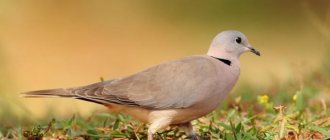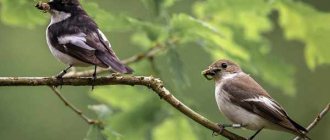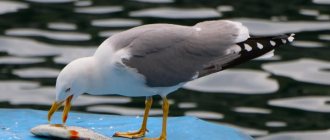The hazel grouse is a bird of the pheasant family of the Galliformes order. It lives in the forest and taiga zones of Eurasia. There are 11 subspecies of hazel grouse, which differ little from each other. The bird got its name thanks to its pockmarked plumage, with the help of which it skillfully hides from enemies, merging with trees and bushes.
Hazel grouse in the snow
Description of the bird
Size
The length of an adult hazel grouse with a tail is from 35 to 37 cm, the wingspan is from 48 to 54 cm. The weight of males is from 327 to 580 g, for females from 305 to 560 g. The weight of birds varies depending on the time of year, it reaches maximum values in November-December. During the winter, hazel grouse lose weight and become much smaller in size in the spring.
— Advertising —
The head of the hazel grouse is small, the beak is short, curved, strong, about 1 cm long.
Plumage
The plumage is variegated, consisting of black, red, brown and white spots and stripes, but it is not contrasting, and from a short distance the bird appears to be colored smoky gray with a reddish tint. The eye ring is red, the iris is black. The beak is black, the paws are dark gray. In flight, the hazel grouse has a dark stripe visible near the base of the tail.
Peculiarities
The male has a black spot on his throat and a prominent crest on his head, unlike the female, in whom it is poorly developed. But in general, sexual dimorphism is insignificant: the male has a black throat and bottom of the head, and the female has a gray one. The female is slightly smaller in size than the male. In autumn and winter, the hazel grouse looks lighter and grayer due to the wide edges on the feathers of the winter plumage.
Legends about the hazel grouse
There is an old Evenki legend about the hazel grouse. It says that a long time ago the hazel grouse was a very large bird. When the hazel grouse flew, all the animals and birds ran away in fear, trees broke, branches fell to the ground. Once the Evenk god decided to inspect his possessions - he was flying on a sleigh drawn by deer. Suddenly he hears noise and din, all the animals run away, the trees crack. God stopped and decided to see what was happening, who was making so much noise. He sees a hazel grouse flying. He called the bird to him and asked: “Why did you make such a noise, break trees, scare birds and animals?” The hazel grouse answered embarrassedly: “That’s how I fly, I’m just very big.” Then the Evenk god said: “Then we will divide your meat equally among all representatives of chicken.” Since then, the hazel grouse has greatly decreased in size, but some white meat remains in its chest part. All other birds of the order Galliformes have a small part of white meat under a layer of red meat. The hazel grouse quickly came to terms with its miniature size, but still takes off noisily.
Christians also have legends about hazel grouse with a similar meaning:
- For example, in the Siberian folklore Bible there is a story about how a large hazel grouse scared Jesus Christ. After this, he decides to reduce it in size and divides his meat among other birds.
- There is another story about how a large hazel grouse flew out of the forest and scared Christ and St. Nicholas the Pleasant as they walked through the taiga. At the same time, Jesus fell on the block and was seriously hurt. To ensure that the hazel grouse does not scare or harm anyone anymore, Jesus decides to distribute its strength and meat among other birds. Therefore, chicken, black grouse, wood grouse and other galliformes each have a share of white hazel grouse meat.
- In Russian Siberian folklore there is a legend about a hero who rode his horse through the taiga. Suddenly a huge hazel grouse flew towards him and frightened the horse so that he fell to his knees. The hero got angry and chopped the bird into small pieces, which he scattered across the field for the birds to eat.
The hazel grouse is also associated with signs that predict the weather. If a hazel grouse spends the night in clearings in the snow, the night will be frosty but windless. If during a thaw a bird plans to spend the night on a pine or spruce tree, it means there will be frost.
What does it eat?
— Advertising —
Hazel grouse feed mainly on plant foods, but also consume animal food. The diet of birds is seasonal.
Nutrition in spring and summer
In spring and summer, the hazel grouse searches for food on the surface of the ground, and feeds mainly on grass seeds and berries: strawberries, blueberries, lingonberries, and boneberries. The bird also eats insects and spiders, but in small quantities. Hazel grouse, which live in the southern regions, include ants, slugs, beetles, and orthoptera in their diet. At the end of summer and early autumn, hazel grouse willingly pecks at rowan fruits.
Nutrition in autumn and winter
The hazel grouse's autumn and winter diet consists of catkins and buds of deciduous trees, and the soft tips of branches. In winter, the bird eats such food even when it is frozen and icy.
Feeding the chicks
In the first days of life, chicks eat animal food: insects, ant pupae (“eggs”), but quite quickly switch to a plant diet consisting of green plants and berries.
Nutritional Features
For normal digestion, the hazel grouse swallows small pebbles, which crush the food. Already at the age of 10 days, chicks peck at grains of sand and pebbles made of quartz or limestone. Hard bones (bird cherry, rose hips, stone fruits) serve as a replacement for pebbles.
Useful tips for beginners
When raising birds for eggs, it is important to consider their monogamy. There should be approximately the same number of females and males in the enclosure.
Home-bred hazel grouse are threatened by dogs, cats, weasels and even hawks. A nimble bird can escape and this should be remembered.
In winter, there is nothing better for a hazel grouse than a large snowdrift, so if snow falls, you should not clear the enclosure of it.
Hazel grouse is a wild bird, the meat of which is used to prepare delicious dishes. Hazel grouse live in coniferous forests, but they can also be raised in captivity. With the right business plan, a hazel grouse breeding enterprise can bring good profits.
Watch the video on the topic:
Where does it live?
Hazel grouse is widespread in the forests of Eurasia: from Western Europe to the Kolyma Range, Japan and Korea. Western breeding sites are in eastern France and Belgium. The southeastern border of the range includes Altai, Khangai, Khentei, Greater Khingan and Korea. The hazel grouse is also found on the islands of Sakhalin and Hokkaido
The overall population of hazel grouse is declining due to human influence on wildlife, so its habitat is often disrupted.
The hazel grouse is a forest bird that lives in mixed forests with rugged terrain, streams, ravines, and clearings.
Enemies
Hazel grouse chick.
There are many hunters for this small bird. The main enemies of hazel grouse are sable and fox. Birds are also in danger from the air. They are not attacked by the golden eagle, eagle owl or goshawk. Mostly young birds die; adult, experienced birds die much less frequently.
From time immemorial, hazel grouse have been known for their tasty and tender meat. Therefore, the main danger for these birds is, of course, humans. At all times, hazel grouse were hunted and considerable damage was caused to the population. The season opened in summer and autumn. In spring, shooting hazel grouse is prohibited. However, in dense forests and taiga, the population of this species is not on the verge of extermination, due to the high birth rate and rapid growth of the younger generation.
If you find an error, please select a piece of text and press Ctrl+Enter.
Common types
Severtsov's hazel grouse (Bonasa sewerzowi)
The body length of the bird is from 33 to 36 cm. Males are slightly larger than females, their weight ranges from 290 to 375 g, while that of females is from 270 to 310 g. The plumage is the same as that of the common hazel grouse.
The species lives in the mountains of southeastern China, which border the Tibetan Plateau. The bird lives in mixed forests with an abundance of dead wood.
Collared Fritillary (Bonasa umbellus)
The body length of the species is from 43 to 48 cm. The wingspan is 60 cm, the beak is about 2 cm. The weight ranges from 500 to 650 g (can reach 800 g). The plumage of the collared hazel grouse, living in the southern borders of its range, is dominated by red-brown color, while northern birds are characterized by gray plumage. The color is variegated, consisting of spots and stripes on the upper part of the body. The abdomen is yellowish-gray. The beak is dark brown. Paws are yellow-gray.
The bird lives in North America: in the USA, Alaska, Canada, in coniferous and deciduous forests, as well as along roads, in meadows and arable lands, and even on rocks covered with vegetation.
Habitat
The common hazel grouse is a typical forest dweller. The bird is most often found in the taiga of northern Eurasia. The range of this representative of the Galliformes order covers Northern Europe, Siberia and the island of Hokkaido in the east.
The types of forest plantations according to their importance in the life of birds can be placed in the following sequence:
- spruce-deciduous, mainly spruce-alder forests;
- spruce-pine forests;
- mixed young forests, birch forests;
- oak-alder and oak-pine forests.
In addition, this hen of the woods loves areas with low relief and abundantly overgrown river banks.
Hazel grouse have a clearly defined seasonality in their chosen habitats . They live in dense deciduous forests and spruce forests all year round. Birds prefer to live in oak and birch forests in the summer. The hazel grouse moves on the ground or hides in the crown; it never sits on the tops of trees. In case of danger, the bird flees or quickly flies vertically into a tree, where it hides at a height of 5-7 meters. It is very difficult to track down a bird hiding in the crown - it is perfectly camouflaged, clinging to the branches of trees and hiding in the branches. The hazel grouse stays in the forest and never flies far. He avoids crossing open places.
Reproduction
Hazel grouse are monogamous birds, strictly attached to their nesting territory. At the end of March or at the beginning of April, the mating period begins. It lasts until mid-May or even early July, depending on climatic conditions.
Mating season
The current male emits a characteristic whistle, fluffs up his plumage, and runs along the ground, spreading his tail and wings like a fan. Each male hazel grouse displays in its own area, separately from the others. The female approaches the male's whistle and emits a rough, abrupt whistle in response.
Nest
The female builds a nest on the ground, under a bush or a pile of dead wood, where it is least noticeable. This is a small hole, lined from the inside with dry grass and leaves, 20-22 cm in diameter and about 5 cm in depth. Egg laying occurs in May.
Laying eggs
The eggs of the hazel grouse are smooth, shiny, brownish-yellow in color. There are from 3 to 14 of them in one clutch. Only the female incubates the eggs. The male remains close to the nest. The incubation period is 21 days. The variegated color of the female allows her to camouflage well with her environment.
The chicks are born in downy plumage and immediately begin to run. Already on the second day of life, the babies themselves find insects and caterpillars that they feed on. The females help them, and the males stay nearby.
Having reached two weeks of age, hazel grouse chicks begin to fly and gain weight. At two months, young birds catch up with adults in weight. After they finish molting, the brood disintegrates.
Keeping and breeding hazel grouse in captivity
Hazel grouse are kept and bred mainly for hunting or meat production. In the first case, the raised bird is released into the wild to hunt for it. With the second option, you need to find a meat buyer - usually expensive restaurants buy it.
If you are seriously thinking about breeding hazel grouse, you will need:
- a plot of at least 10 m²;
- netting for the enclosure;
- spruce or pine seedlings, as well as berry plants;
- incubator;
- feeders.
Hazel grouse are usually kept in cages or enclosures. To place them, choose a place protected from the wind, away from dogs. It is important to consider that birds living in a cage do not reach their full size and weight. Also, in conditions of lack of space, the female will not lay eggs. Therefore, the cage is only suitable for keeping chicks and young birds up to 1 year old. To keep 7 individuals, the width and length of the cage should not be less than 5x5 m.
An aviary with an area of 10 m² is best suited for hazel grouse. They do it like this:
- mark the corners of the enclosure, drive metal or wooden stakes in this place;
- a stretched mesh is tied to the supports;
- the ceiling is made of the same material as the walls or a fabric fishing net.
A hazel grouse chick with its mother.
The walls of the enclosure should have a fine-mesh structure so that the hazel grouse cannot stick its head into the hole and get hurt. The enclosure must contain: a container for swimming, several spruce trees and berry bushes to create a food supply, as well as feeders installed on the ground.
The hazel grouse's menu will be based on spruce needles and berries from bushes growing in the enclosure. The owner will have to periodically feed the birds grain.
Sometimes it is necessary to check the enclosure for the presence of tunnels that could be made by a dog, cat or small predator. Otherwise, the hazel grouse will run away from its owner through a small hole. In winter, snow or dry leaves serve as shelter for the hazel grouse. If there is little or no snow, you need to put a bunch of leaves in the enclosure. This will be an excellent shelter from the cold.
Caring for eggs and offspring
Female hazel grouse in captivity do not build nests and can sit directly on the clutch. Therefore, after laying a clutch, the eggs are taken and placed in an incubator or allowed to hatch by ordinary chickens. A calm, small-sized chicken is suitable for this task.
HELPFUL INFORMATION. Adult hazel grouse or their eggs can be purchased from farmers who breed these birds.
On the first day after the chicks are born, they dry out, and the next day they can be released to graze in a fenced area. Chickens will initially eat small insects, but then switch to plant food.
Interesting Facts
- In winter, hazel grouse, like black grouse, spend the night in snow cover.
- The hazel grouse population is decreasing, but still remains numerous and is not in danger of extinction. Up to 40 million individuals live in Russia.
- Hazel grouse is an important game bird; its meat is considered a delicacy. In the past, hundreds of thousands of carcasses of this bird were exported every year from the Russian Empire and the USSR. Today, hazel grouse remains a popular object of sport hunting.
Exquisite varieties
This perennial is in most cases represented by varieties of imperial hazel grouse - when the flowers are collected in buds at the crown and decorated with a bunch of leaves (crown).
The most attractive variety in all respects is Maxima Rubra: voluminous flowers - up to 5-7 cm bud length, bright orange with red notes and purple veins . The cultivar is quite tall - up to 1.2 m in height. Maxima is considered a frost-resistant hazel grouse - it tolerates down to -30 ° C, and is undemanding to soils. It will delight you with flowers in April.
Flowers of the hazel grouse Maxim Rubra have a not very pleasant musky smell
The Aurora variety has buds of a bright, piercing carrot color, no more than 4 cm long, but this cultivar itself is capable of growing a stem up to 1.5 m. At the top, the peduncle, like most other varieties of imperial hazel grouse, is crowned with a light green bunch of leaves - the so-called crown. Flowering starts in the 1st–2nd decade of April.
The Aurora hazel grouse has become famous for its beauty from Moscow to Vladivostok
The yellow-flowered variety Lutea is the brightest representative of hazel grouse of all light-colored varieties. Lutea reaches a height of 0.8–1 m, blooms in early May (in the middle zone of our country).
Hazel grouse Lutea - the solar messenger of spring
Hazel grouse Akmopetala is an amazing variety of hazel grouse in all respects. The flowers of the cultivar are drooping, pale burgundy with green markings (length 3 cm). The height of the Akmopetala variety does not exceed 0.4–0.5 m. The plant grows well in the shade.
Hazel grouse Akmopetala - Mr. Extraordinary
The Peach fritillary is called a mourning flower. But rather it is mysterious: violet-gray small funnel-shaped buds densely strew the stem of a tall plant (height up to 1.1 m). Peach blooms in a temperate continental climate in early May.
Peach hazel grouse has become famous for its unusual shades of petals
Meleagris Alba is a low-growing hazel grouse (up to 0.3 m), one of the most frost-resistant. This cultivar takes root well in the conditions of Eastern Siberia, the Urals, and North-West Russia. The peculiarity of the variety is its snow-white small bells with greenish tan marks. Meleagris prefers drained, fertile soil and periodic moisture; it blooms in late May - early June.
Hazel grouse Meleagris Alba - tenderness itself
Imperial hazel grouse Striped Beauty has peach-colored buds with expressive lines of brick-burgundy tones on the petals. The height of the variety is about 0.9 m, the flowers are collected in bunches at the crown, like other varieties of imperial hazel grouse. This is a May variety.
The Striped Beauty hazel grouse has buds decorated with stripes
